
Bud Shuster Highway
Appalachian Thruway

Bud Shuster Highway
Appalachian Thruway
The first section of this Interstate that gives some indigestion to be built was from south of Bedford Springs to Exit 3 in 1969. Constructed along with the US 30 bypass of Bedford, the part from south of Bedford Springs to the interchange with Business US 30 is a two-lane limited-access design known as a "Super 2."
The 1970s began with this section opening to traffic in the first year of the decade. In the same year, construction began on the section between Exit 45 and Exit 52 which was originally the Tyrone Bypass of US 220. Five years later construction commenced on the section from Exit 3 to the Blair County line. In 1976, the Tyrone Bypass opened to traffic.
The section between Exit 3 and a temporary exit to take traffic back to the original US 220 alignment at current Exit 15 started in 1975 and was completed five years later. Blair County would finally see construction taking place in 1982, when the section between the Newry Lane underpass to Exit 31 was started. Just as in Bedford County, the segment was built along with a US route being upgraded to an expressway which was the US 22 expressway to Ebensburg. Construction was extended from Exit 31 to Exit 33 two years later. In 1986, this section from a temporary Newry Lane interchange to Exit 33 opened to traffic which alleviated congestion in downtown Altoona. With that completed, attention turned to the section between the temporary interchanges at Exit 15 and Newry Lane which became marked as proposed on the 1986 Department of Transportation map. It wouldn't take long for that gray, dashed line to be turned into a colored one as construction began on it the following year. In 1988, the section from a new temporary interchange at PA 164 to the one at Newry Lane opened, which prompted its closure. The final year of the 1980s saw the segment between Exit 15 and the temporary interchange at PA 164 open and that temporary interchange close.
After the Bedford to Altoona link had been completed, there was the gap between Altoona and Tyrone left to close. Construction began in 1991 to close that gap between Exit 33 and Exit 45. It opened to traffic in 1995, creating an uninterrupted route from south of Bedford Springs to north of Tyrone: free of cross traffic, traffic signals, and slow trucks trying to navigate narrow, mountainous, old US 220.
However, not all things were quiet on the Central Front. In 1996, Representative Bud Shuster who acquired funds for the upgrading of US 220, had this highway designated an Interstate in Section 322 of the National Highway System Designation Act of 1995. Something that I agreed should have happened; that is where the agreeing stops! Bud had his highway designated I-99 and had the designation written into law. It was bad enough it runs past his son's car dealership, and violate Interstate highway numbering system too! It should have been numbered I-576, 776, or 976. I like the last...a fitting number for someone that had been under investigation for illegal highway funding acts, and was reprimanded by the House ethics committee for accepting improper gifts and favoring a lobbyist by the name of Ann M. Eppard as The Washington Post reported. In September 2000, the Committee on Standards of Official Conduct criticized Shuster for "serious official misconduct" but did not penalize him any further.
On January 4, 2001 Bud Shuster announced he was retiring after 14-terms in the House of Representatives due to recent "health scares." He said he didn't want to wait until the end of his term because he didn't want to become a lame duck; however it's OK do damage the numbering system and name a highway after himself. We thought maybe we had finally gotten rid of the name Shuster in congress; however, we were wrong. In March 2001, his son Bill announced he would run for his father's vacant seat. He won the May 15 election by 52% over his opponent Scott Conklin.
After almost four years of construction, the next section to open was from the Mount Nittany Expressway to the Bellefonte Bypass on November 25, 2002. Ribbon cutting ceremonies started at 10 AM at the Park Avenue interchange near Beaver Stadium, which marked the official opening of the expressway.
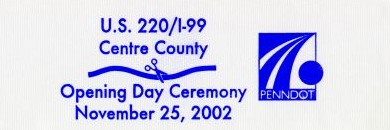
Piece of ceremonial ribbon used at the opening of
the
section from US 322 to PA 26.
(PennDOT; courtesy of Geoff Hatchard)
The official name of the project was the PA 26 Relocation Project, which started in January 1999 and cost $195 million to build. The Bellefonte Bypass section of the expressway was built in 1971 and opened in 1972 as a "Super-2" expressway, a two-lane expressway built on a four-lane right-of-way. In 1997, the other lanes were built to make it a four-lane highway. As other expressway projects in Pennsylvania, an open house was held on October 26, 2002 called a "Roll & Stroll." Around 1,000 people are estimated to have walked, biked, skated and strolled along the new expressway. A four-mile race to benefit the United Way of Centre County was held on the right-of-way, with Penn State's ROTC cadets participating with the public. This section will not officially become part of I-99 until 2007 when the Bald Eagle to Mount Nittany Expressway section is completed.
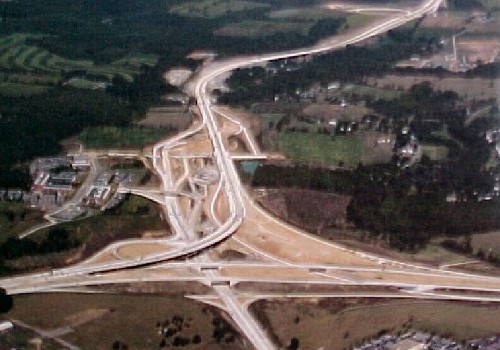 Looking northward at the interchange with US 322 in State College in Summer 2002. (PennDOT) |
|
|
|
|
 Construction
began in Fall 2000 on the section from Bald Eagle to State College with
completion originally scheduled for late 2003. However, that changed in
February 2004 when construction crews unearthed vast quantities of acid rock at
Skytop Mountain. Gary Byron, assistant regional director for the state
Department of Environmental Protection said he has never seen a bigger potential
for stream damage than the uncovering of this material. "It's the
worst I've seen, and I've been here 27 years," he said. "The
bottom line is, PennDOT's environmental-impact work for I-99 missed this
geologic formation." Between 500,000 and one million cubic yards of
acid rock, previously sealed in geologic formations, is now exposed to rainwater
that drains into Buffalo Run which is a tributary of Spring Creek. Byron
went on to say that the rock "is rare, but it is very wicked in chemical
composition." Soda ash briquettes are being used to neutralize the
acidic drainage as it washes into the stream. On March 8, the Department
of Environmental Protection shut down construction in a half-mile section until
a solution could be reached. By August, the run-off had contaminated 19
wells requiring one home to have bottled water to supplant the contaminated
stuff coming out of the faucets. Three wells became contaminated during a
90 minute hearing in Harrisburg about the acid rock run-off.
Construction
began in Fall 2000 on the section from Bald Eagle to State College with
completion originally scheduled for late 2003. However, that changed in
February 2004 when construction crews unearthed vast quantities of acid rock at
Skytop Mountain. Gary Byron, assistant regional director for the state
Department of Environmental Protection said he has never seen a bigger potential
for stream damage than the uncovering of this material. "It's the
worst I've seen, and I've been here 27 years," he said. "The
bottom line is, PennDOT's environmental-impact work for I-99 missed this
geologic formation." Between 500,000 and one million cubic yards of
acid rock, previously sealed in geologic formations, is now exposed to rainwater
that drains into Buffalo Run which is a tributary of Spring Creek. Byron
went on to say that the rock "is rare, but it is very wicked in chemical
composition." Soda ash briquettes are being used to neutralize the
acidic drainage as it washes into the stream. On March 8, the Department
of Environmental Protection shut down construction in a half-mile section until
a solution could be reached. By August, the run-off had contaminated 19
wells requiring one home to have bottled water to supplant the contaminated
stuff coming out of the faucets. Three wells became contaminated during a
90 minute hearing in Harrisburg about the acid rock run-off.
 A sediment basin near the PA 550 overpass used to monitor run-off. The mainline of the Interstate is on the right side behind the orange safety fence. |
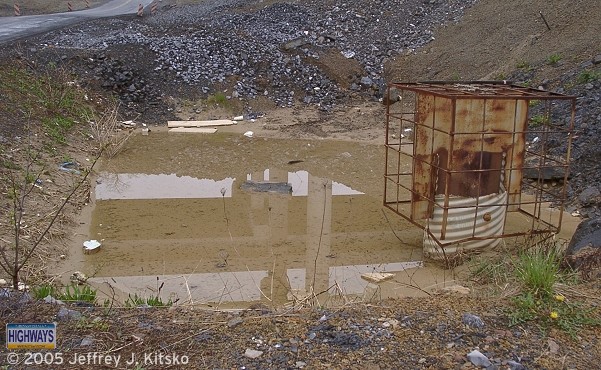 Stormwater basin on the side of PA 550 near the overpass. |
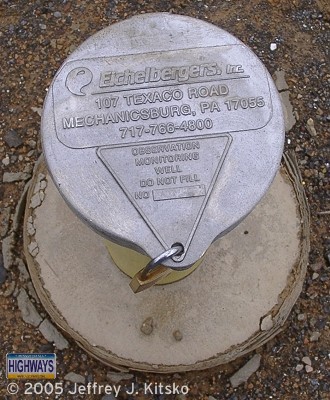 Well to monitor seepage into the groundwater. |
Removal of the pyritic rock was placed in the hands, or trucks, of an Indiana County company. A $26 million contract to haul piles of approximately 650,000 cubic yards of the rock 75 miles away to a fly ash pit near Ebensburg was signed by Robindale Energy Services in January 2006. An additional $14 million would go to covering up the 400,000 cubic yards that will remain on Skytop Ridge. When started in the summer, the operation had 50 trucks making three round trips a day for 200 days or 30,000 truckloads. The fly ash in the mine helped neutralize the sulfuric acid. The other option PennDOT explored was building an "engineered rock placement area" to dump the pyritic rock on Skytop. A third option to use Bauxsol was dismissed in 2005. Even though it worked effectively, the state determined it would be too difficult to apply it to all of the affected areas.
Some of the rock had to stay on the ridge, either on a rock face or to act as support for the Interstate. To shield it from oxygen and water, the areas were covered with three layers of impermeable plastic as well as lime-kiln dust and synthetic webbing. A $1.5 million permanent surface water collection and treatment facility, which uses sophisticated filtering equipment, to clean and safely return run-off water back into the environment was built in 2012. PennDOT District 2 has information on the pyritic rock issue on this page.
In April 2006, Transportation Secretary Allen Biehler announced the total cost of clean up would be $50.5 million. By 2008, the cost rose to $79 million because of two factors. Two years earlier oil was trading at $70/barrel and officials were expecting to only have to truck 667,000 cubic yards, rather than 1 million cubic yards, of rock to the disposal site. However, the final cost of clean-up totaled $100 million.
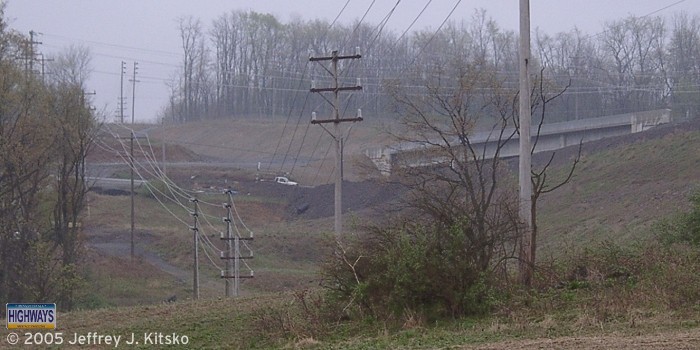 View from PA 550 looking towards the former and current US 220/US 322 alignments. |
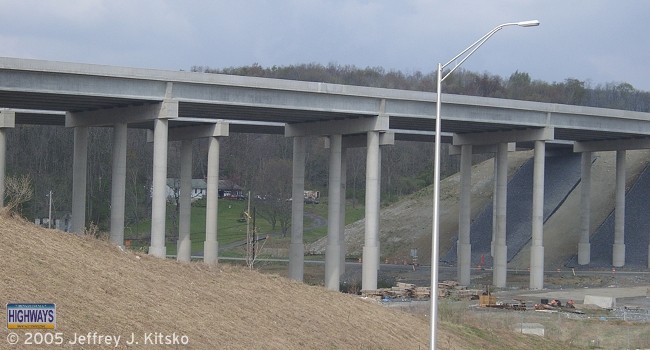 Bridges over Sellers Lane just west of State College. |
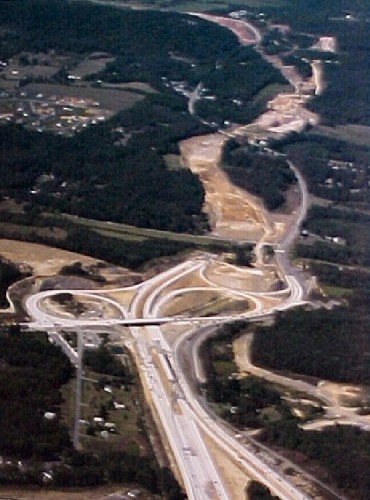 Looking southbound towards Bald Eagle Mountain at the Gray's Wood interchange in Summer 2002. (PennDOT) |
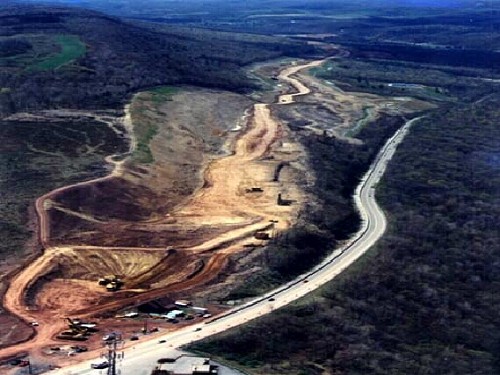 Facing southbound on Bald Eagle Mountain in September 2002. The highway running through the picture was the former alignment for US 220/US 322. (PennDOT) |
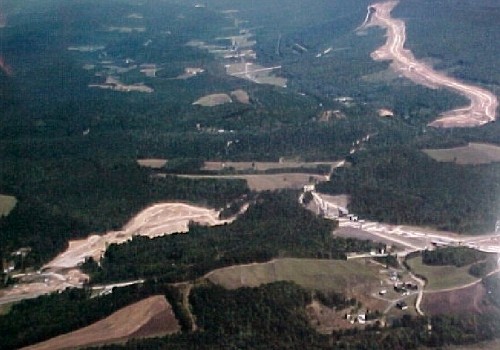 Facing northeast from Port Matilda towards State College in September 2002. (PennDOT) |
After seven years of construction, and delays involving pyritic rock, a portion of the Bald Eagle-to-State College segment opened on December 17, 2007. The northbound lanes from PA 350 to Skytop Mountain and southbound lanes from Port Matilda to PA 350 were supposed to open thirteen days earlier, but the opening was postponed to give crews more time to prepare. The opening was then moved to December 13 before it was cancelled due to winter weather.
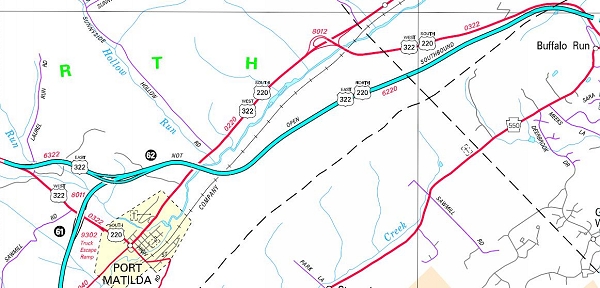 While clean-up of acid rock kept the southbound side of the expressway closed, US 220/US 322 had its opposing directions split. |
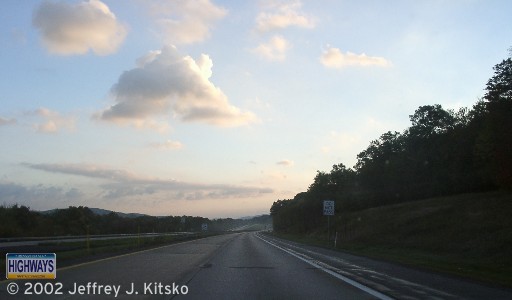 Before construction began, traffic was narrowed to one lane and forced to exit at PA 350. |
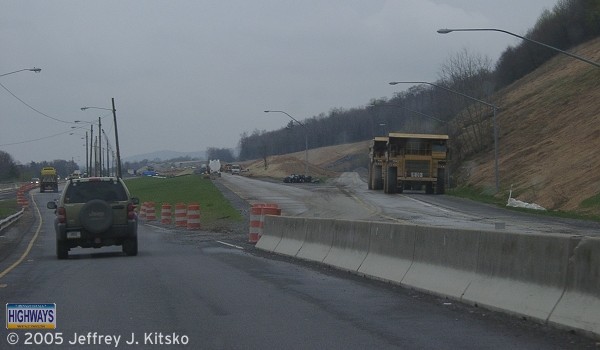 During construction, traffic must detour onto a temporary roadway. In the middle is the former stub end and where the large dump trucks are parked is the old exit ramp. |
Even though the cleanup of the acid rock continued, PennDOT decided to open as many completed sections to move as much traffic off the antiquated US 322 as possible. Eastbound traffic used a temporary ramp on Skytop Mountain to rejoin the former alignment while the westbound traffic continued to use the former route. Federal, state, and local officials gathered on November 24, 2008 to mark the completion of the expressway and pay tribute to former US Representative Bud Shuster who spearheaded the effort for high-speed route through central Pennsylvania. "This project became a reality through the tireless work and dedication of Congressman Bud Shuster," Secretary of Transportation Allen Biehler said. "Bud was instrumental not only for making this roadway a reality in the region, but for delivering the entire corridor." Shuster himself spoke at the opening by saying I-99 "really was the premier dream...seeing an Interstate going north to south through our region." The acid rock clean up, which added $82 million to the cost, was alluded to a few times but not mentioned outright. The highway opened at 3 PM which was just in time for its first winter weather test that evening as most of it is higher than the original route and therefore its bridges freeze faster.
Bald
Eagle to Port Matilda ![]() - PennDOT
- PennDOT
Port
Matilda to State College ![]() - PennDOT
- PennDOT
Before the Interstate 99 designation could be extended from Bald Eagle to Interstate 80, Congress had to pass legislation to amend the definition of the route. The reason it had to be extended in that manner was because the designation was written into law, and any further extensions must be also be approved by Congress. Interstate 99 was officially designated between those two points on December 10, 2008.
The first 70 MPH speed limits were posted in 2016 from mile marker 0 to mile marker 27 and mile marker 33 to Exit 68. The speed limit on the section in Centre County between the Gray's Woods interchange and mile marker 84 near Interstate 80 was increased from 55 to 65 MPH in April 2019. The increase took place after the findings of requested speed studies determined that a raise would not be detrimental, and done in accordance with federal and state regulations.
Since the entire section from Williamsport to the New York state line was finished completely in 2011, people have often wondered why markers were not posting along the highway. The main sticking point was what to do with Four Mile Road, which makes a direct, at-grade connection with the northbound lanes between the PA 14 and Cogan House interchanges. With a remedy in the works, PennDOT applied to the American Association of State Highway and Transportation Officials on August 29, 2024 to add this piece to the current Interstate 99 mileage. AASHTO approved the application at their Annual Meeting on October 30, 2024 in Philadelphia.
Links:
Exit Guide
Interstate 99 Ends
Interstate 99 Pictures
I-99/US 220 Construction Progress Map
I-99/US 15 Construction Progress Map
US 220
Pennsylvania I-99 Summary Report - Federal Highway Administration
Interstate 99 - Andy Field/Alex Nitzman
Interstate 99 - David Steinberg
Interstate 99
Pictures - Andy Field/Alex Nitzman
Interstate
99 Pictures - Steve Alpert
Interstate
99 Photos - Valerie Deane
Kurumi's Trippy Drive '71 - Scott Oglesby
|
UNDER CONSTRUCTION
On March 6, 2006,
PennDOT announced changes to the interchange to avoid a similar fate to the
Skytop Mountain section. The revised plan moves the interchange closer
to Nittany Creek, reduces the amount of material to be moved by 400,000
cubic yards, and retaining walls instead of hillside excavation. The
discovery of pyrite is not new as PennDOT had known about it for two years
and as more surveying and core borings took place, the necessity of reducing
the impact of the interchange on the seam became more apparent. The
changes will not result in any cost savings, but compared to paying for
remediation of the acid rock drainage, it will end up cheaper than the
alternative. Bidding on the $80 million high-speed interchange was to
have begun in December 2008, with the local interchanges at Jacksonville Road and
I-80 at Shay Lane scheduled to be bid at the end of 2006.
Talk about the
interchange began again in 2009 when at a meeting of the Centre County
Metropolitan Planning Organization on June 10, Chairman
Kent Baker urged building the two interchanges even with opposition from
Howard, Marion Township, and local residents. The roadblock in the way
for the CCMPO was resolving controversy over the local interchange with
Jacksonville Road which would help in securing $150 million to start construction.
Marion officials said they do not oppose the high-speed interchange but fear
the local interchange would attract too many cars and trucks to a
sub-standard roadway. They came to the meeting with a document signed
by 182 residents against the local interchange and only six in favor.
The volunteer fire department in Howard sided with Marion officials but
officials from Spring Township and Bellefonte have written the MPO and
PennDOT is support of the dual interchange plan. An idea to combine
the two interchanges was dismissed due to the confines within the Nittany
Creek gap through Bald Eagle Mountain. Marion Township officials
offered a compromise if the local-access interchange could not be eliminated
in PennDOT improving Jacksonville Road and Hubler Ridge Road from the
I-80/I-99 interchange to PA 150 north of Howard. PennDOT has only
committed to a three-mile improvement of Jacksonville Road between the
interchanges, far short of the ten proposed wanted by Marion Township.
Benner Township engineer Doug Weikel insisted that his motion in support of
the local interchange not include the improvements so as not to cause
problems with procurement of funding. On
June 23, 2009, the Centre County Metropolitan Planning Organization voted to
move forward with plans for the I-80/I-99 interchange and the local
interchange nearby. Officials want to tap into $1.5 billion in
American Recovery and Reinvestment Act monies to help with the projects that
total $162 million. PennDOT has finished design work for the $43
million local interchange and is completing design of the $119 million
high-speed interchange. Plans are to acquire $50 million to $60
million from the Appalachian Regional Commission with stimulus money
covering the rest of the costs. President of the Howard Volunteer Fire
Company Thomas Bowes objected to the Interstate 80 interchange with PA 26
saying that traffic from the interchange in addition to the potential
re-opening of the Jacksonville stone quarry would jeopardize response time
but create the potential for severe or fatal accidents on Jacksonville
Road. Bellefonte opposes abandoning the local interchange because
truck traffic would end up on the borough's older streets not designed for
truck traffic. The Federal Highway Administration warned the CCMPO
that if the interchanges are scrapped, the Commonwealth will have to repay
approximately $27 million in federal money spent on design.
Local transportation
planners originally designated the high-speed I-80/I-99 interchange as the number one transportation priority
on the draft of Centre
County's Long Range Transportation Plan at a meeting on March 23, 2010 of the Centre County Metropolitan
Planning Organization. Then, much to the delight of local residents
and Marion Township officials, the CCMPO reversed their
decision and removed the project due to fiscal constraints. With the
interchange put on hold, the organization changed its focus towards
reconfiguring the ramps and replacing the overpass at the Waddle Road
interchange.
The interchange gained traction in March
2019 when PennDOT unveiled plans to construct the local access interchange
two miles east of the current PA 26 interchange on Interstate 80. The
$34 million project is expected to be put up for bids on April 23, 2020 with
completion scheduled in December 2021. The next bids would go out in
March 2022 for improvements to Jacksonville Road, bridge improvements to the
eastbound and westbound structures over Hubler Ridge Road and Sand Ridge
Road on Interstate 80, and construction of the high-speed interchange
between it and Interstate 99. The Jacksonville Road improvements are
planned to be completed by July 2023, the bridge improvements by December
2023, and the high-speed interchange by December 2025. "It opens
up the extension of I-99, but the feds are still looking," said PennDOT
Assistant District Executive of Design Thomas Zurat. "Probably the
biggest concern for 99 right now is the section going up to
Williamsport. Once you get up into Lock Haven and up into Jersey
Shore, it narrows down with a lot of houses and businesses for just a short
section and then it opens back up to four lanes. That is kind of the
restriction right now. It wouldn’t take us much to connect 80 to the
Lock Haven bypass; that lower part is farm fields and you could do
that. It’s the piece north of that that would be a little more
difficult." The three-phased
project to finally tie Interstate 99 and Interstate 80 together began July
17, 2020. Funding through a federal Infrastructure for Rebuilding
America grant amounting to $35 million was announced in July 2018.
While the actual construction began on July 27, crews placed work zone and
traffic control signs between Exit 161 and Jacksonville Road ten days
earlier. Preliminary work included erosion and sedimentation
control in addition to building emergency pull-offs which will cost
approximately $52 million. Phase Two was construction of the local
interchange with PA 26 that is located two miles to the east of the
current interchange at Exit 161 on Interstate 80 and cost $4.4
million.
Phase Three, which began on September 4,
2024, will be construction of the actual high-speed
interchange between the two Interstates. Work will includes
building the interchange, ten bridges, four retaining walls, five box
culverts, seven sign structures, and three changeable message boards.
It also includes constructing new and rebuilding existing roadways and
ramps, drainage improvements, installing Intelligent Transportation System
devices, guide rail and highway lighting, pavement marking, stream
improvements, and miscellaneous construction. Construction is
estimated to be complete in 2030 and cost $259 million. Project website: https://www.penndot.gov/SR26Localinterchange.
|
|
PROPOSED |
 INFORMATION
INFORMATION |
| Southern Terminus: | Business US 220 in Bedford |
| Northern Terminus: | Musser Lane in Bellefonte |
| Length: | 85.60 miles |
| National Highway System: | Entire length |
| Names: |
Appalachian Thruway Bud Shuster Highway: Exit 1 to Exit 69 Mount Nittany Expressway: Exit 69 to Exit 73 Bellefonte Bypass: Exit 81 to I-80 |
| SR Designation: | 0099 |
| Counties: | Bedford, Blair, and Centre |
| Multiplexed Routes: | US 220: Entire
length US 322: Exit 62 to Exit 73 PA 26: Exit 81 to Musser Lane |
| Former Designations: | None |
| Former LR Designations: | 1061: Exit 1 to Exit 33 1050: Exit 69 to Exit 73 |
| Emergency: | 911 |
 Traffic Cameras: |
Cross
Keys Plank Road Logan Boulevard Frankstown Road 17th Street PA 350 Grays Woods US 322 Park Avenue Weaver Hill Road |
| Advisory Radio: | 1630 AM |